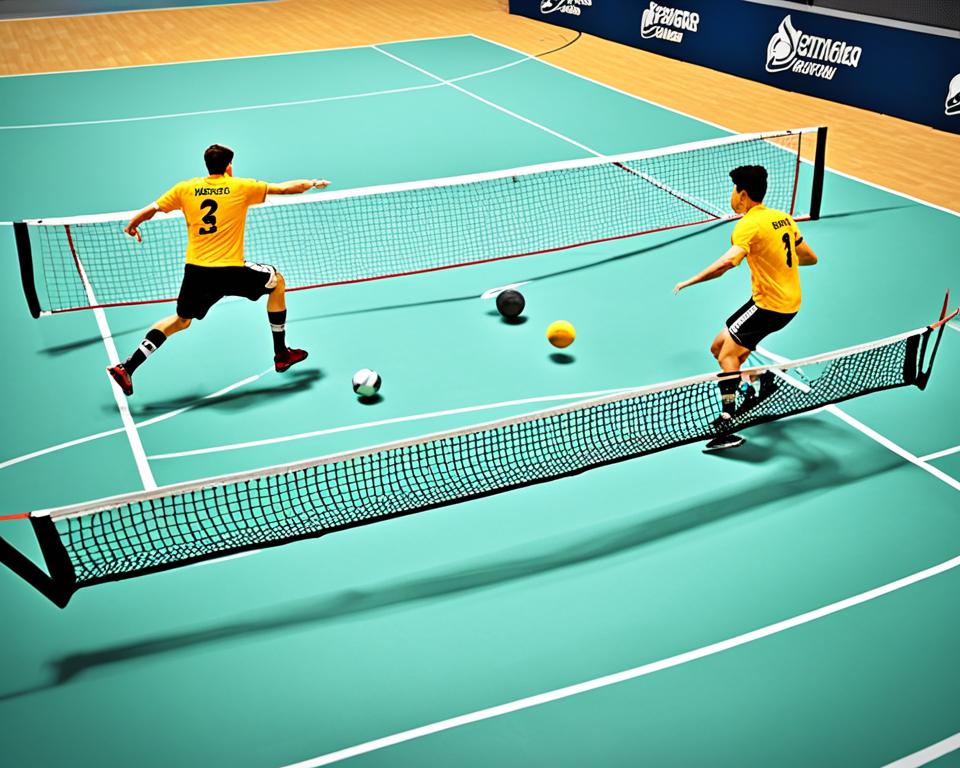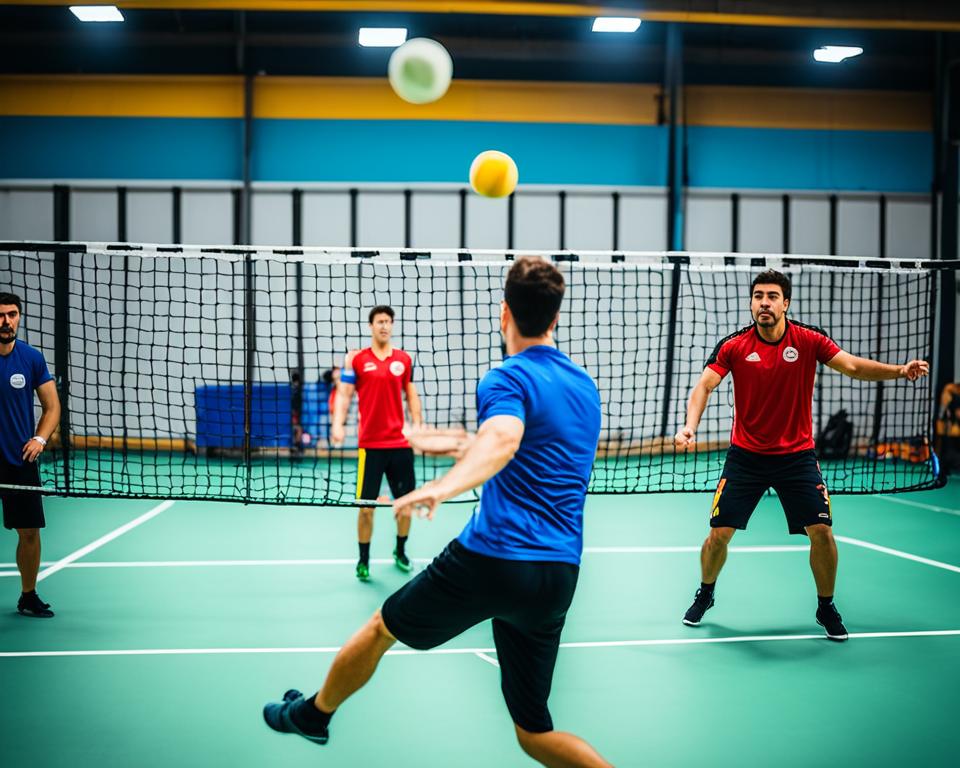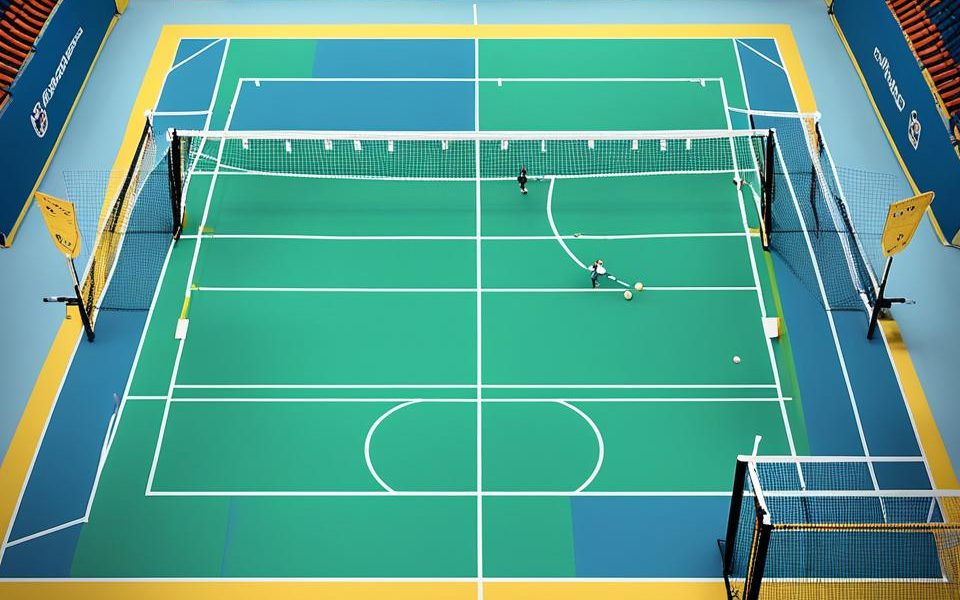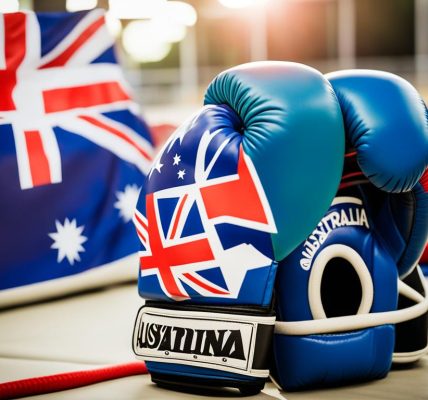A sepak takraw court is 13.4 meters long and 6.1 meters wide. Most courts are found indoors or outdoors. They can be on wood, rubber, sand, dirt, or grass. But, every court must be flat and clear of any objects for safety and fair play.
Sepak takraw has a net that runs down its middle. This net is as wide as the court. It hangs at 1.52 m for men and 1.42 m for women. The ball is special too. The ancient ball was woven from rattan. Today, most balls are made of rubber or plastic. They’re 42-45 cm across and weigh 170-180 g for men, 150-160 g for women.
Read more interesting information at ::ds-collection
Introduction to Sepak Takraw
Sepak takraw might have come to Southeast Asia from China. There, the game Cuju was first played. This was a military game where soldiers kept a feather-filled leather ball in the air. They did this by kicking it back and forth.
The earliest known sepak takraw games used balls made of woven rattan. This was found in the 15th century in the Malacca Sultanate, which is now Malaysia. An ancient Malay document mentions this.
In Thailand, the game was played during the time of King Naresuan (1590–1605) of the Ayutthaya Kingdom. The game as we know it started shaping up in the 1940s. It became popular thanks to three people from Jalan Patani, Penang in Malaysia. They introduced the “Sepak Raga Jaring” version in 1945. This version is seen as the start of modern sepak takraw.
Sepak Takraw as a Sport
Sepak takraw is a team sport played with a small ball in a court. The court looks like a badminton court. It is like a mix of volleyball and footvolley. Players can use their feet, knees, shoulders, chest, and head to hit the ball.
So, it is known as a mix of volleyball, because of the net, and soccer, because players use their feet. The modern version of the sport was shaped in 1960. That year, officials from Malaysia, Singapore, Thailand, and Myanmar agreed on its name and rules.
sepak takraw court Dimensions
Length and Width
A sepak takraw court is 13.4 meters long by 6.1 meters wide. This is the standard size. But, the sport is flexible and can be played on different sizes, like badminton or volleyball courts.
Surface Types
Games can happen indoors or outdoors on various surfaces. Inside, you might find wood or rubber floors. Outside, courts can be on sand, dirt, or grass. No matter the type, the court must be even and clear of anything that can get in the way of players enjoying the game safely and equally.
Court Layout and Markings
Sepak takraw courts have service circles and lines to show where players should be. The player serving, called the Tekong, stays in the serving circle. The other two, the bowler/setter and striker/killer, start at the net’s corners. The setter is on the left, and the striker is on the right. Start positions can only be left after the ball goes over the net.
Service Circles and Lines
Each sepak takraw team has three players. The server, or Tekong, serves from the serving circle. The bowler/setter and striker/killer wait at the net’s corners. Their positions are in a half-circle, with the setter left and the striker right. Moving from these starting spots is only allowed after the ball goes over. The other team can move freely while waiting for the serve.
This creates an area where roles are clear and strategic during the game. It’s part of what makes sepak takraw exciting to watch.
Sepak Takraw Net Specifications
In games like sepak takraw, the sepak takraw net divides the court. It must be as wide as the court itself, which is 6.1 meters. For men’s play, the net is set at 1.52 meters (5 ft) in height. For the women’s games, it’s slightly lower, at 1.42 meters (4ft 6in). Normally, the net is woven from a kind of mesh, and it’s around .7 meters wide (2.3 ft/ 28 in).
Net Height and Width
sepak takraw net measurements include a width of 0.7 meters. It must be at least 6.10 meters long. The top height is usually 1.52 meters, but for women, it’s 1.42 meters. This net is typically made from fine ordinary cord or nylon. It has a mesh of 6 to 8 cm.
The Sepak Takraw Ball
In sepak takraw, the ball is not like any other. The first balls were woven from rattan, which is a strong, light, and flexible wood vine. This style of ball was used in the sport’s early times.
Traditional Rattan Ball
Nowadays, the sepak takraw ball is more commonly made of rubber or plastic. This change makes the ball last longer and is easier on the players. Most competitive games now use these synthetic balls.
Modern Synthetic Balls
The official size for a sepak takraw ball is 42 – 45 cm (16.5-17.7 in). For men, it should weigh 170-180 g (6-6.3 oz). Women’s should be 150-160 g (5.3-5.6 oz). It doesn’t matter if it’s made of rattan, rubber, or plastic, the ball always must have 21 intersections and 12 holes.
Ball Dimensions and Weight
Sepak Takraw Rules and Regulations
This sport is played with two teams. Each team has three players: the server (Tekong), the bowler/setter, and the striker/killer. Players have specific places to stand at the starting point.
Players can only kick the ball using their feet, knees, chest, or head. The goal is to send the ball over the net without it hitting the ground on the other team’s side. If the other team can’t return the ball, you get a point. The game ends when a team reaches 15 points first.
Team Composition
Each team in sepak takraw has three players. The server is in the serving circle. The bowler and striker are at the net’s corners. They stand in a half-circle, with the bowler on the left and the striker on the right. Once the ball goes over the net, players can move from their positions.
Scoring and Gameplay
The main goal in sepak takraw is to get the ball over the net, without letting it touch the ground. Each team can touch the ball three times maximum before sending it back. If the other team can’t hit the ball over, they get a point.
One set is won by being the first to reach 21 points. If the score is tied at 20-20, you must get to 25 points. The winning team must be ahead by 2 points. You need to win two sets to win the match.
If the Tekong jumps during service, the ball isn’t kicked, or the ball doesn’t pass the net, the other team gets a point.
| Sepak Takraw Rules and Regulations | Details |
|---|---|
| Court Dimensions | 13.4 x 6.1 meters |
| Net Height | 1.52 meters for men, 1.42 meters for women |
| Ball Specifications | 12 holes, 20 intersections, 170-180 grams for men, 150-160 grams for women |
| Team Composition | 3 players per team, including Tekong, bowler/setter, and striker/killer |
| Scoring and Sets | First to 21 points, with tie-breaker to 25 points. Best of 3 sets. |
| Touch Limit | Maximum 3 touches per team before ball must cross net |
Governing Bodies and Competitions
Sepak takraw is managed worldwide by the International Sepaktakraw Federation (ISTAF). It was created in 1988.3 ISTAF handles big competitions like the ISTAF SuperSeries (ISS) and the ISTAF World Cup (IWC). It also looks after local events, for example, Malaysia’s Khir Johari Cup and Thailand’s King Cup.
International Sepaktakraw Federation (ISTAF)
The International Sepak Takraw Federation (ISTAF) works from Singapore. It’s a central authority for sepak takraw.7 ISTAF was set up in 1988 with a mission to grow the sport all over the world.
Major Tournaments and Events
The top competitions in sepak takraw are the ISTAF SuperSeries (ISS) and the ISTAF World Cup (IWC). These are run by the International Sepaktakraw Federation. Nationally, events like Malaysia’s Khir Johari Cup and Thailand’s King Cup are popular. Sepak takraw is also featured in multi-sports events like the Southeast Asian Games.
| Tournament | Organizer | Description |
|---|---|---|
| ISTAF SuperSeries (ISS) | International Sepaktakraw Federation (ISTAF) | A high-level international sepak takraw competition featuring top teams and players from around the world. |
| ISTAF World Cup (IWC) | International Sepaktakraw Federation (ISTAF) | The premier global event for sepak takraw, held every two years to crown the world champion team. |
| Khir Johari Cup | Malaysia | A national sepak takraw tournament organized annually in Malaysia, one of the sport’s strongholds. |
| King Cup | Thailand | Thailand’s premier sepak takraw event, attracting top teams and players from across the country. |
| Southeast Asian Games | Southeast Asian Games Federation | Sepak takraw is a regular event at the multi-sport Southeast Asian Games, showcasing the region’s top talent. |
Equipment and Gear
Sepak takraw only needs a few things – a ball, a net, and the right shoes. The sepak takraw ball is special, usually made of plastic or rubber today. It’s around 42 to 45 cm (16.5-17.7 in) big and weighs 170-180 grams (6-6.3 oz) for men, and a bit lighter for women. The net must be at least 0.7 meters wide (2.29 ft) and 6.10 meters long (20 ft). Players use special sepak takraw shoes designed with a good grip and support for their ankles. This helps with the game’s difficult kicking moves.
| Equipment | Specifications |
|---|---|
| Sepak Takraw Ball |
|
| Sepak Takraw Net |
|
| Sepak Takraw Shoes |
|
Variations and Regional Styles
Sepak takraw has many related traditional games in Southeast Asia. Each game has its own cultural touch. For example, Sepak Raga is played in Brunei, Indonesia, Malaysia, and Singapore.
In Indonesia, you’ll find Takraw and Rago/Raga. The Philippines plays Sipa, Myanmar has Chinlone, and Thailand has Takraw. Laos enjoys Kataw and Cambodia plays Sek Dai.
Even though the core game is alike, there are differences. These include rules, gear, and the local customs that shape their style. This makes each region’s sepak takraw unique.
Sepak Takraw in Southeast Asia
Sepak takraw is at the heart of Southeast Asia’s culture. It has been played for centuries. The game we know today started in 1960. This is when leaders from Malaysia, Singapore, Thailand, and Myanmar met to set common rules.
Now, sepak takraw is very popular in Malaysia, Thailand, Indonesia, and the Philippines. It’s seen as a national game in these places. The game’s mix of sports, quick moves, and cultural meaning amazes people all over the region and the world.

Benefits and Skills Involved
Sepak takraw is tough and fun, needing lots of athleticism. You should be great at balancing, and have quick reflexes. Players use feet, knees, chest, and head to move the ball. You get in great shape, improve your balance, and get mentally strong.
Physical and Mental Benefits
Playing sepak takraw boosts health in many ways. It’s like a big cardio workout, getting your heart strong and your body fit. Your muscles, like the legs and arms, become strong from all the jumping and kicking. You also become really flexible, able to move and stretch well.
The game is great for your mind too. It’s fast and needs you to think on the spot. You learn to act fast and deal with any surprises. And, since it’s a team sport, you get good at working with others, figuring out the other team’s plan and beating them together.
Skills Required
To be good at sepak takraw, you need lots of skill. This means playing the ball well with your feet, head, and more. You also need to jump high and have quick eyes to predict what’s next. It’s more than just being strong; it’s about being smart too.
The core of sepak takraw is how you handle the ball. It takes a long time to get really good. Most importantly, you must be able to hit the ball accurately. This is key for scoring points and winning.
Besides being skilled, you need to be super fit. The game asks a lot of your body, like jumping high and moving fast. Good players not only have the moves but the energy too. This helps them play well and beat their opponents.
| Sepak Takraw Skills | Description |
|---|---|
| Ball Control | Mastery of kicks, headers, and body traps to move the ball with skill |
| Acrobatics | High jumps and spins to catch and control the ball |
| Tactical Awareness | Knowing where to be and guessing the other team’s moves to plan better |
| Hand-Eye Coordination | Catching the ball fast and hitting it accurately |
| Physical Athleticism | Staying fit and strong for the game’s tough moves |
Getting Started with Sepak Takraw
Sepak takraw isn’t very well known around the world. But more and more people are getting into it, especially in places with lots of Southeast Asians. People in countries like Malaysia, Thailand, and the USA love playing it. If you’re interested, look for clubs or take classes at community centers or schools. The court is about the size of a badminton court. Make sure the court has the right markings, like for badminton.
Finding Local Clubs and Resources
It’s super helpful to connect with people who know about sepak takraw. They can teach you how to play and other important stuff. The sport uses your feet a lot, so you need to be coordinated and flexible. Learning moves like the inside kick and header is key.
Look for clubs and community centers to start. They might have coaches and equipment to help you get going. You’ll also meet other people who love the game.

Popularity and Future of the Sport
Sepak takraw is Malaysia’s favorite sport and is very popular across Southeast Asia. The game is becoming more popular globally too. This is because more people are taking an interest in this unique sport.
This attention is bringing the sport to new parts of the world. Its mix of physical ability, skill, and cultural history appeals to many. Therefore, the future of sepak takraw looks bright, suggesting it will grow even more.
| Key Factors Driving Sepak Takraw’s Global Growth |
|---|
|
Sepak takraw is well set for a bright future. Its unique properties attract many people worldwide. This dynamic, traditional game is sure to succeed and grow further.
Conclusion
Sepak takraw is not just unique; it’s captivating, with a history deeply rooted in Southeast Asia. It blends volleyball, football, and martial arts into a thrilling game, unlike any other. Sepak takraw is full of action and challenges. Players must master its specialized techniques and strategies.
The sport is becoming more popular worldwide. This growth promises new chances for people to enjoy its physical and cultural benefits. Its global appeal is growing because of its unique mix of athleticism, skill, and cultural background. These aspects are drawing more interest and players from around the globe.
Sepak takraw offers something special that many people have yet to discover. With its rich past, special gameplay, and unique equipment, this sport stands out. It’s a breath of fresh air from mainstream sports. Both players and fans will find it unforgettable. The future looks bright for sepak takraw. It’s on its way to becoming more widespread, with exciting possibilities for the sport and its community.




